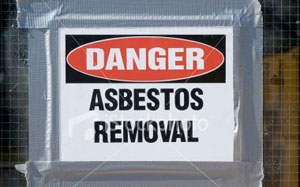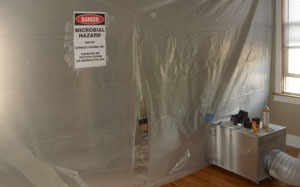Mold Removal in Homes
To remove mold, Bluestone utilizes methods that have been proven successful over the past several decades. In general, Bluestone’s mold remediation projects involve the following steps:
- Prior to doing any mold removal work, Bluestone workers isolate the work area from the occupied areas.
- A H.E.P.A.-filtered negative air machine is used to establish a negative air environment, and prevent airborne mold spores from escaping the work area.
- Workers then put on protective suits and respirators and enter work area.
- When remediating mold-contaminated drywall and other porous, non-structural elements, we carefully remove the building materials, wrap them in plastic sheeting or place them into bags, and immediately remove those materials from the home.
- When remediating contaminated structural members or other building components that cannot be removed (e.g. floor joists, wooden framing studs, etc.), Bluestone workers first disinfect those surfaces with a biocide solution and then abrasively clean the surfaces by scraping, sanding or wire brushing.
- The remaining surfaces are then encapsulated with an EPA-registered antimicrobial coating that is designed to kill residual mold and inhibit possible future mold growth.
Mold Removal in Buildings
To remove mold, Bluestone utilizes methods outlined in the Standard and Reference Guide for Professional Mold Remediation, (IICRC S520, Second Edition, 2008). A typical Bluestone mold removal project will involve the following steps:
- Prior to doing any mold removal work, Bluestone workers isolate the work area from the occupied areas of the building.
- A H.E.P.A.-filtered negative air machine is utilized to establish a negative air environment in the work area in order to prevent airborne mold spores from migrating from the work area.
- Mold remediation workers then put on don protective suits and respiratory protection, and enter work area.
- When abating mold-contaminated sheetrock, drywall, or other porous, non-structural elements, we carefully remove the building materials, wrap them in plastic, place them into bags, and immediately remove those materials from the building.
- When remediating contaminated structural members or other building materials that cannot be removed (e.g. studs, wooden frame work, etc.), Bluestone workers disinfect those surfaces with a biocide solution and then clean the surfaces by scraping, sanding or wire brushing.
An anti-fungal encapsulant is then applied to the remaining surfaces. The encapsulant is an EPA-registered antimicrobial coating designed to kill residual mold and prevent future mold growth.
Asbestos Removal in Buildings
The main steps involved in a typical Bluestone asbestos removal project are:
- Prior to performing any asbestos removal work, Bluestone workers establish a regulated work area and isolate that area from the rest of the building.
- High Efficiency Particulate Air (H.E.P.A.)-filtered negative air machines are utilized to establish a negative air environment to prevent migration of asbestos fibers from the work area.
- Workers put on protective suits and respirators and then enter the work area.
- Workers carefully remove the asbestos materials while using amended water.
- All surfaces are H.E.P.A. vacuumed and wet wiped as a final clean.
- An encapsulant is applied that locks down possible asbestos fibers that may remain after final cleaning activities.
- All waste in the work area is double-bagged, properly labeled and transported from the building in accordance state and federal regulations.
- An independent testing company conducts a final visual inspection. If the work area passes the visual inspection, the testing company conducts clearance air testing to verify that the work area is safe for re-occupancy.
Bluestone follows the regulations and guidelines of the Illinois Department of Public Health (IDPH), the Environmental Protection Agency (EPA) and the Occupational Safety and Health Administration (OSHA).
Asbestos Removal in Homes
In general, Bluestone’s asbestos removal projects consist of the following steps:
- Prior to conducting any asbestos removal, Bluestone workers isolate the work area from all other areas of the home.
- A high efficiency particulate air (H.E.P.A.)-filtered negative air machine is used to create a negative air environment and to prevent asbestos fibers from escaping from the work area.
- Workers then put on protective suits and respirators and enter the work area.
- Using amended water (to minimize the airborne asbestos fiber levels), workers carefully remove the asbestos materials.
- Workers then remove all visible debris from the work area. All surfaces are HEPA-vacuumed and wet-wiped as a final clean.
- An encapsulant, which locks down any possible asbestos fibers remaining after final cleaning activities, is sprayed over surfaces in the work area.
- All waste in the work area is double-bagged, properly labeled and transported from the home.
- An independent environmental testing company conducts a final visual inspection work area. If the work area passes this visual inspection, the testing company conducts a clearance inspection and air testing.
Mold Abatement in Attics
A variety of attic building materials (i.e. wooden joists, sheathing, insulation, etc.) become susceptible to mold growth when exposed to excess moisture. While the source of moisture varies, this often occurs when the attic is improperly ventilated or when exhaust fans direct moisture into attic space, instead of outside the home.

Bluestone Environmental Approach to Mold Remediation in Attics
Bluestone remediates attic mold using time-tested, effective, EPA-approved methods. Listed below are the main procedures that Bluestone uses while remediating mold in attics:
- Prior to conducting any mold removal activities, Bluestone creates a contained work area to isolate the attic from all other areas of the home
- A high efficiency particulate air (H.E.P.A.)-filtered negative air machine is placed in the attic to create a negative air environment
- Workers then put on protective suits and respirators and enter the attic
- Workers remove all mold-contaminated, porous materials (e.g. insulation, drywall, etc.). All removed materials are carefully bagged and removed from the home
- Bluestone then applies a biocide solution to the remaining structural members (e.g. wooden studs, joists and sheathing)
- Workers abrasively scrub all remaining structural members. Finally, to discourage future mold growth, an anti-fungal encapsulant is applied to all remaining structural members

Air sampling professional
analyzing clearance air testing slide
Final Inspection and Clearance Testing
After asbestos removal work in a particular area is completed, a final inspection and clearance air testing is performed to confirm that the work area is safe for re-occupancy. According to state regulations, clearance testing cannot be conducted by the remediation company. The usual charge is around $400.
The most important part of the clearance process is the final inspection. The independent environmental technician visually examines the substrate surfaces to ensure that no asbestos-containing material (ACM) remains. Special attention is given to horizontal and irregular surfaces and hard-to-reach areas. If any quantity of ACM remains, the site fails the visual inspection, and additional removal and/or cleaning needs to be performed before another visual inspection is conducted.
After the work area passes the visual inspection, air samples are collected by a state-licensed air sampling professional (ASP). Air sampling cassettes are attached to an electric-powered vacuum pump usually operating at a flow rate of around 10 liters per minute. Air flows through an open-face, 25-mm diameter filter. The air sampling typically takes about an hour and a half.
The filters from the cassettes are typically analyzed on-site by the ASP. The analyst uses the phase contrast microscopy in accordance with the National Institute of Occupational Safety and Health Method 7400.
Most residential asbestos removal projects are priced assuming that clearance sample analysis will be done on-site, directly following the completion of the project as described above. If off-site analysis or transmission electron microscopy TEM testing is performed, the price of the asbestos removal project will be increased since the abatement company will have to return to the site to dismantle the containment and retrieve equipment sample analysis is completed.
Chicago Asbestos, Mold, & Lead Paint Removal
Bluestone Environmental is a Chicago area remediation company that specializes in asbestos removal and mold removal for residential and commercial properties. Bluestone offers free site visits and prompt, written estimates. Above all, it is our mission to help clients (homeowners, businesses, contractors, and municipalities) to find common-sense, cost-effective solutions to their asbestos and mold problems.
For ten consecutive years (2011 – 2021), Angie’s List has awarded Bluestone “Super Service” Awards for both of our service categories (Asbestos Removal and Mold Removal Services). Additionally, our company has a “5-Star” rating on Google Reviews and we hold an “A+” rating with the Better Business Bureau. If you have a mold or asbestos problem, we’re happy to help! Contact us today for a free, no-obligation cost estimate.
BLUESTONE PROVIDES THE FOLLOWING SERVICES

Asbestos Removal Chicago

Asbestos Testing Chicago

Mold Removal
Bluestone Environmental Google+









